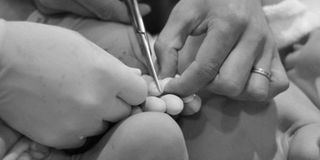Care for umbilical cord

After three years in marriage, Emily Asaba was excited to receive her first baby. However, being a first time mother, the baby was so fragile that she was not sure how she was going to manage the baby’s umbilical cord.
“The midwife gave me instructions on how to care for the umbilical cord. But feared to clean it. I thought I would hurt my baby,” she recalls.
Just like Asaba, many first time mothers do not know how to care for the umblical cord which makes it prone to infections.
Caring for the cord
An umbilical cord is a conduit between the growing embryo and the placenta, according to Dr Junior Ndozire, a gynaecologist at Mildmay Uganda.
“It is a genetical part of the foetus and a canal through which a baby feeds during pregnancy. At birth, the health worker cuts, clamps and ties the cord with a ligature to stop bleeding.”
Since the baby’s heart and blood vessels are directly connected to the umbilical cord, if left untied, the baby can bleed to death.
“First time mothers are oriented on how to care for the cord during antenatal and postnatal visits to health units,” says Dr Ndozire.
Dr Nestor Mbabazi, a paediatrician at Mulago hospital, warns that the baby’s cord should only be cleaned after 24 hours, after the baby has been born. “The cord is sterile with no dirt or germs until after a day. It should only be touched during cleaning. If it is frequently touched, it increases the risk of infection to the baby.”
He says: “The umbilical cord heals and falls off by decay mechanism within a week after birth but sometimes, it may take five or even 10 days. Clean it with normal saline water which contains sodium chloride.”
He adds: “The more careful the mother is with the cord, the lesser the number of healing days. In some cultures, mothers use herbs, soil, cow dung, which are unhygienic and can cause infections to the baby,” she adds.
Preventing infections
Dr Mbabazi says mothers can make saline water by boiling water and adding a little salt to it but it should just taste like the one in a meal. “Cool the water to lukewarm temperature to suit the baby’s temperature. Use a soft material such as a cotton swab or gauze and clean around the cord.”
She cautions: “Do not exert a lot of pressure while rubbing the cord.The cleaning should be done twice or thrice a day to facilitate the healing process.”
Asaba advises mothers to wash their hands with soap before they touch the cord as well as wash and iron all baby’s clothes to prevent infections. She also adds: “Limit the number of people who carry the baby when it still has a cord.”
Risks involved
The commonest type of infection to the cord is bacterial and tetanus. The following signs show that the cord has an infection according to Dr Mbabazi:
• Bleeding
• Pus discharge
• The cord turns red
• The baby gets a fever, cries all the time and refuses to breastfeed
“Sometimes an umbilical cord may fall off but a remnant of flesh remains. The condition is known as granuloma and is treated by cauterisation, where the remaining flesh is burnt, using some medicine for some days until it completely heals,” says Mbabazi.
This can only be done by a qualified general doctor or a pediatrician.”




